2010 categories
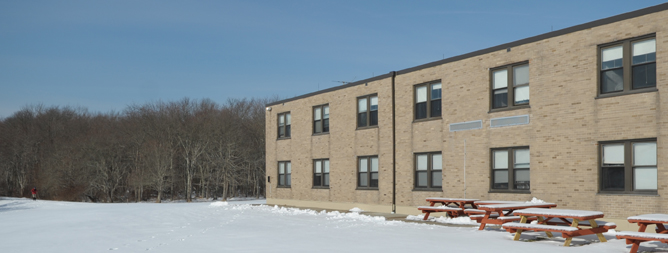
The 2010 category-group contains the following categories:
Boston-2010
Christmas-2010
Harrow-10
Kitchens
Michigan-2010
Murals
Narragansett
Pgh-2010


The 2010 category-group contains the following categories:
Boston-2010
Christmas-2010
Harrow-10
Kitchens
Michigan-2010
Murals
Narragansett
Pgh-2010
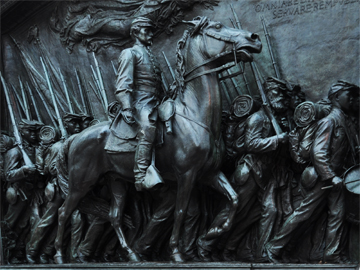
 It was late afternoon and grey only as New England can be grey in winter. I’m slowly beginning to learn how to shoot in this light and some of the images I got, I like very much. Also processing them through Photoshop can alter them enough to compensate for the grey and the diminished light.
It was late afternoon and grey only as New England can be grey in winter. I’m slowly beginning to learn how to shoot in this light and some of the images I got, I like very much. Also processing them through Photoshop can alter them enough to compensate for the grey and the diminished light.
My goal in walking the Common was to shoot the Augustus Saint-Gaudens relief – The Robert Gould Shaw Memorial – commemorating Shaw and the Afro-American 54th Massachusetts Volunteer Infantry. Saint-Gaudens is one of my favorite sculptors. (The other piece I’m determined to shoot is the Adams Memorial in Rock Creek Cemetery in Washington, DC.) I shot the relief with little light remaining and yet I think the image works.
..
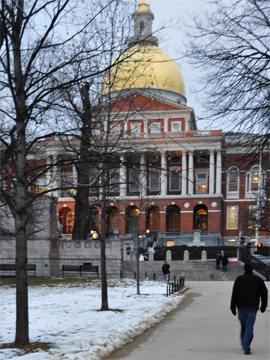 I walked through Boston Common with Ryan Oliver. The area is a great place full of people – students, street performers, policemen on horses and workers heading home. The Common is dotted with great statuary and they were fun to shoot in the dying light. The last time I was here must have been some thirty years ago and never in winter.
I walked through Boston Common with Ryan Oliver. The area is a great place full of people – students, street performers, policemen on horses and workers heading home. The Common is dotted with great statuary and they were fun to shoot in the dying light. The last time I was here must have been some thirty years ago and never in winter.
The second pic is of Mr. Oliver walking towards the Massachusetts’ State House. (I had to get stern with Mr. Oliver who wanted to turn and mug while I shot.) I’m using the pic to place the Shaw Memorial. (Sorry Mr. Oliver.) The back of the monument is on the left hand side, in the middle of the pic. It sits across the street from the State House facing the golden dome.
Oliver had lived in Boston for a good six years so it was great to have him guide through the city. Boston is more like New York than it is like any other city I know. However, it doesn’t have the oppressive feeling of NYC.
I always think of Boston as America’s Jerusalem – the Golgotha where England was killed and a new nation resurrected.
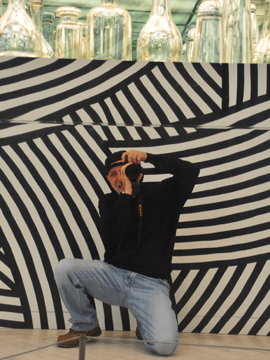

The first time I ever shot in a museum was last fall in Portland. That experience was interesting mainly because I ended up using the wide-angle lens and focusing on items I could shoot with the flash. And by getting real close, the lens gave me some great pictures. (I keep forgetting the adage – walk to the subject, don’t zoom it.) On Saturday, I wasn’t sure what to expect when I walked into the Boston Fine Arts with my camera. This time I mounted the 18-200mm – f/3.5 not sure what the results would be. This is my work-horse lens. What I didn’t expect was a well-lit environment. Can you imagine, it never occurred to me that objects in a museum would be well-lit. Once I figured that out, I shot everything I liked.

The image on the left is probably my favorite. It’s my ‘Antonioni’ picture. I’m referring to the poster for the film BLOW-UP, Antonioni’s first English language movie, released in 1966. I may not be straddling super-model Veruschka, but the image is as close as I’ll ever get to the iconic pose on the famous poster.
What you’re looking at is a reflection. I am shooting the image in the mirror. The mirror is the base of the display – Endless. The bottles above the mirror are the actual display. The black swirls are in the wall paper I’m kneeling in front of.
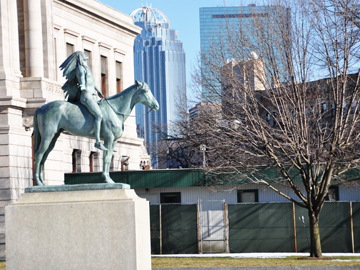
 After the cemetery Mac and I went to the Boston Museum of Fine Arts. All the time I visited Mac in Boston when he was in grad-school, we never went to the museum. Forty years later we head to The Fenway. The museum is undergoing a huge renovation almost doubling its size. In the process it is surrounded by fencing. The sculpture, with its green patina, is in front of the museum’s original entrance, now re-opened to the public.
After the cemetery Mac and I went to the Boston Museum of Fine Arts. All the time I visited Mac in Boston when he was in grad-school, we never went to the museum. Forty years later we head to The Fenway. The museum is undergoing a huge renovation almost doubling its size. In the process it is surrounded by fencing. The sculpture, with its green patina, is in front of the museum’s original entrance, now re-opened to the public.
I’m using this image of the Indian pleading to heaven, because to me it has some of the same sentiments as The Shaw Memorial of the Afro-American Volunteer Infantry in the Common. I find it strange that prominent in this first of American cities are two pieces – one to the conquered and one the oppressed. After all, it was the colonist who took the land from the people they found in the new world and in ’67 Boston was the site of some of the most violent race riots of the era. Yes, Massachusetts is one of the most politically liberal of states, but I never think of it as progressive towards its people.
I will add pictures of the museum in the Additional Pages on the places text-section of the webpage.
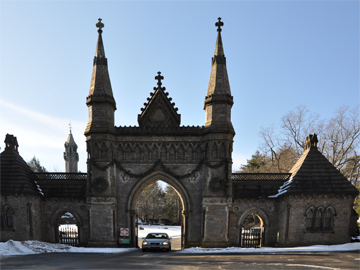
 Saturday morning, Mac and I went first to Forest Hills Cemetery and then to the Boston Museum of Fine Arts .
Saturday morning, Mac and I went first to Forest Hills Cemetery and then to the Boston Museum of Fine Arts .
Forest Hills, chartered in 1848, is among the first ‘park-cemeteries or rural-cemeteries’ in the nation. (Allegheny Cemetery, opened in 1845.) The entrance is Victorian and massive. What I really liked is the bell-tower. In the pic, it’s on the left in the background. It’s a functioning bell-tower and tolls the hours. I haven’t found any other cemetery with a working bell-tower. The picture composition was serendipitous, the car drove through as I was shooting. And I must have shot at the right time to capture the car without any streaking.
I will add pictures of Forest Hills in the Additional Pages on the cemetery text-section of the webpage.
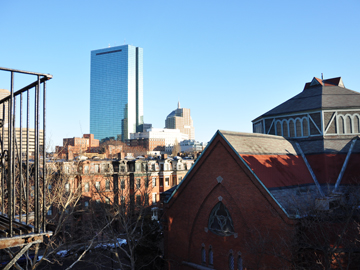
The pic on the right is taken from my window at the Clarendon Square Inn, a B&B that I stayed at.

The neighborhood is full of Second Empire houses, old brick five-story structures with mansard roofs that have been reclaimed and made beautiful again. The B&B is located in Boston’s South End. I had a room on the 5th floor and from my window I could see the high-rises of downtown Boston. The South End reminded me a lot of New York’s East Side.
We have little Second Empire housing in Pittsburgh. One of the owners of the B&B was surprised to know that the Western Pennsylvania region has more Arts and Crafts housing than French influenced architecture. (My neighbors across the street have a mansard roof on the third story.) Pittsburgh, the original gateway to the west, is European in character but American in architecture. The European, upper-class look isn’t here, but Frank Lloyd Wright and H.H. Richardson have left great legacies.
..
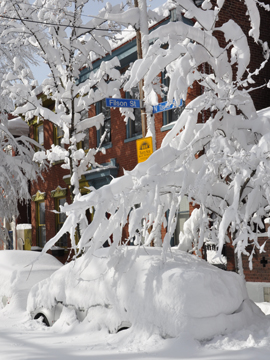
The picture was taken Saturday morning. I’m shooting from the alley-way across the street.

All day Friday, the news media was hyping everyone up with their predictions of snowmageddon. Rick, Sarah and I had a previous date to go to Joan Brindle’s gallery opening and we ignored the hysteria and went to the opening. I drove home proud of having made it from the east-end, via Wilkinsburg, Squirrel Hill, Oakland and to the North Side. The roads were snow-covered and given that the media had scared everyone home, there were very few other cars to navigate or be careful of.
I went to bed thinking that I’d get up early and go take pictures. At 4:00 in the morning I realize that my alarm clock is off and that there’s a chill. I get up and check things and figure out that the electrical had gone off at 11:30 last night. The dogs were not happy in the darkness. A couple of hours later, I get up, make espresso and have breakfast, but still no heat or electricity.
I open the back door to let the dogs out and find that they yard is covered in almost 3 feet of snow. The dogs jump in only to sink and get all snow covered. After the shock of sinking, they begin to eat the snow. They love to eat the stuff. After a lot of shouting I round them up and bring them in only to spend the next half-hour drying them off.
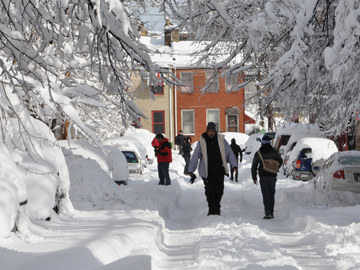
This was the headline in today’s Pittsburgh Post-Gazette. And given that 21 inches of snow fell in 14 hours, and that we were without electricity and heat for 17 hours, the title seems to fit. (A state of emergency was declared throughout Pennsylvania.) I’m using an image shot yesterday. It conveys the amount of snow without the filth of sand and melt.

Yesterday morning everyone was in a great mood. Taylor Avenue was filled with people we all laughed and talked about the fact that none of us had power. Here we were, Pittsburgh’s urban pioneers enjoying a beautiful snow-drenched morning. The sun and snow made it easy to forget that we had no heat and no electricity. That discomfort didn’t set in until sundown and the house was cold and dark.
In the afternoon, I went out and sat in my car for a half hour charging my iPhone and Kindle. (I don’t believe I’ve been alive long enough for such an admission to make sense and to not be embarrassed by this comment.) My neighbors went to a coffee shop in the neighborhood to charge all their peripherals.
The electricity came back this morning at 4:00 – seventeen hours after going off.
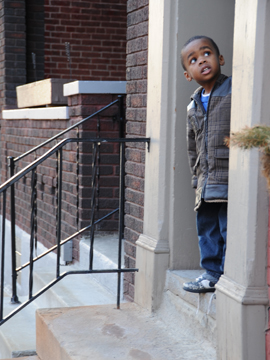
The other day my D90 gave me an error message and then shut down. I removed the battery and it started up again only to shut down again. Went online and started reading blogs and several postings talked about this particular problem. It was described as an electrical problem in the body of the D90.
Next, I called Nikon and they said the same thing and that I had to ship the camera in for repair – shock to the system. I packed it all up and went down to UPS. I was without a familiar camera. Even though, I recently purchased a D700 when offered a “pick-yourself-out-a-gift” offer. But I was intimidated by the fancy, new camera and had not yet used it.

On my way down to UPS, I decided to take the plunge and use the D700 in Auto mode. (I know, I know this could get me drummed out of the “club.”) But then it wouldn’t be the first club I got thrown out of. I read the manual, switched it to Auto and walked out the door.
My neighbor’s kids were playing and I asked them if I could take their picture. (As if they were going to say no.) Here’s one of my favorites.
I agonized over buying the D700 – it’s considered a professional camera and I’m nowhere near that level of proficiency. And never mind the price, even if it was a gift – a gift that was offered back in January. It took me three months before I called and order it and then it sat on my dining room table for the next two weeks. I kept telling myself that I didn’t have time to learn it. It’s funny how things work out. Nothing like necessity to force us to do things we’re afraid of. (At one point, I considered going back to my office and getting my old D60. After all I knew how to use that one and I was already in the car. A short trip to downtown would be easy.)
If I remember correctly, I did the same thing with my first camera – put it on auto and concentrated on composition. It has taken me two and a half years to get to a point where I know my way through the technology to shoot in manual. I hope it’ll be a shorter time with this new, fancy camera.
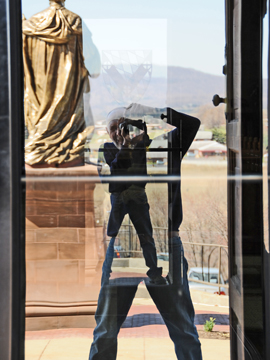
I was out in Westmoreland County, the sun was out and I decided to drive out to St. Vincent College to shoot with the D700.

The doors to the abbey were open so I made a bee-line to the entrance. When I got there, behind the massive wooden doors were two sets of glass doors, and there staring at me was a reflection in a reflection. I couldn’t pass it up.
Now to try and explain the layers – the gold statue is behind me, and its reflection is in the first set of doors. The rolling hills are the western ridge of the Appalachians. My larger reflection is also in the first set of doors. The smaller, full-body reflection is in the second set – the interior doors. The floating, vertical rectangle with the insignia is on the interior doors. The shield is the College’s logo.
Inside, I shot the empty, sterile church of Holy Week. By Sunday it will be festooned in lilies and filled with Halleluiahs. Outside, I found the pond for the old grist mill. (At one time the monks grew wheat, ground it in the mill and made great bread. But those days are gone.) The pond is home to some of the largest gold-fish/carp. And, a group of gold-fish was huddled under rotting leaves. The bright red was in contrast to the browns and dirty-greens of the old autumn leaves.
BTW, I learned that I don’t have the D700 set up correctly. I guess ‘auto’ is a selective feature, not an all encompassing one.
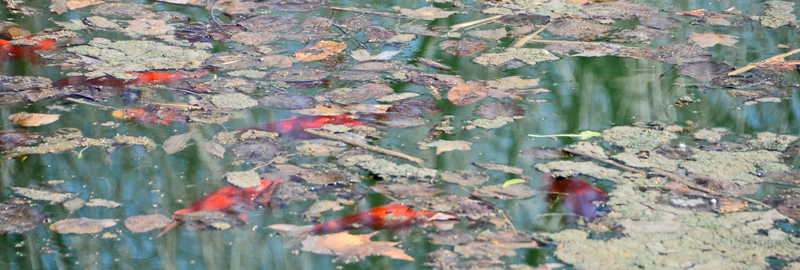
The old gristmill at St. Vincent still has the pond that for years dammed the water that turned the wheel that ground the wheat that became the monks’ bread. Today the mill houses the College’s maintenance and the pond is a nice place to visit on a spring day.

I was standing there shooting the grounds and looked down into the green water and saw all these carp, some of them huge. Farther out, under old leaves and other winter debris was a small group of fish all red and golden. I aimed the lens and shot. The dirty-grey winter leaves, the red carp, the reflected tree-limbs all floating in the cold-green water created an image that reminded me of Monet’s Water Lilies.
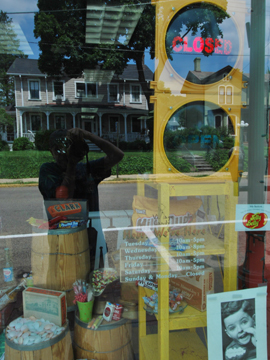
My two high-end cameras are in the shop. And after 3 tries it looks like the problem is the batteries. Nikon has my D90, D700, my 18-200 lens and 4 batteries. (I suspect they may finally be on the right track, because the 18-200 lens is not a problem with the D60.) Also, today was my first day without travel, prom, travel and graduation on my plate. I could finally go out and shoot.
 My first outing was to Sewickley hoping to find some interesting things to shoot, but didn’t. What I did find were some great windows for reflections.
My first outing was to Sewickley hoping to find some interesting things to shoot, but didn’t. What I did find were some great windows for reflections.
This is my first trip shooting in the area in quite a while. I’m troubled, because I want my two cameras back; I really want to shoot with the D700; the picture quality is great. However, I am shooting with my favorite lens – Nikkor 12-24. And regardless, it’s through the lens that I zone out and make pictures.
I walked the main street and was disappointed to find it was deserted and not very interesting. Most of the shops are directed at women and all were closed and shuttered. It doesn’t matter the goal was to get back out there and make pictures.
The picture on the left is fun. There I am in the middle of barrels, candy, fluorescences, ads and a Sewickley frame-house. The ad in the bottom right of the all-American child in the same image as the old immigrant is my sense of fun. I turned the camera to myself out of boredom. Fancy Sewickley had nothing worth shooting.
..
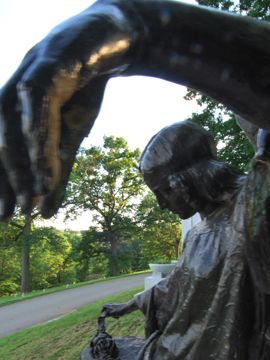

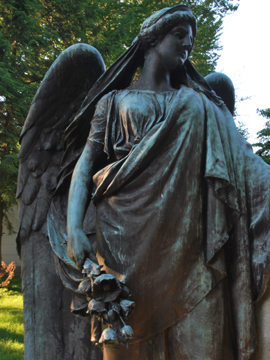
After my disappointing trip to Sewickley, I decided to revisit my two favorite angles in Homewood Cemetery.
I was hoping to find them dripping in evening light. The smaller angel on the left, was in shadow but the large majestic one on the right, holding a bouquet of poppies, still stood in twilight.
..
The Gulentz Angel on the left is the smaller of the two and has a whimsical quality. Her outstretched arm giving her both a melancholy stance and a breadth that encompasses the entire sarcophagus.
The Schoonmaker Angel is elegant and grand. She stands holding poppies in one hand and resting her left hand gently on the sarcophagus, soothing a sleeping child. She is herald, she is mother.

I have all my cameras back. And tomorrow I should have the Canon point-and-shoot. I’ve wanted something that I can have with me all the time and the PowerShot G11 was highly recommended.

There’s no way of knowing if the problem has really been fixed, however this time the techies seemed to attack it more comprehensively. The support manager in California that I’ve been dealing with got the technical manager in New York to work the case. It was the New York person that asked for the lens and batteries. What they found was that two of my four batteries were defective. Also the battery chamber on the D90 had cracked and that got repaired. The battery problems seem right. I already threw away one of the non-Nikon batteries, because it would not keep a charge. But it never occurred to me that what I was buying at a chain camera shop would be defective. I’ve ended up buying and throwing away 3 batteries.
The image on the left was shot with the D700 after a thunderstorm. I put together the D700 with my favorite lens – Nikkor 12-24 – and went out to the back yard. I really like the images from the D700.
The other thing that I did tonight was hang 6 pictures of flower photographs that I shot. (Last fall in Maine, Mac mentioned that he rotated the pictures in his house. There’s what I could do with my photographs – print them, frame them and hang them on a rotating basis.) I gave my friend Scott six flower images that I really liked. He Photoshopped them, printed them and framed them. I know nothing about printing, and I suspect that I will have to learn something about it.
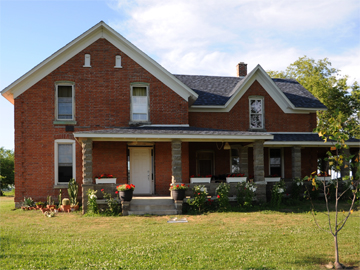
 I spent the week-end in Harrow. Unlike last year, I decided to take pictures of the farm. (The architecture of these Upper Canada farm-houses is consistent all throughout Southern Ontario.) Rainer and Lynne bought the farm-house some 4 years ago and are slowly renovating it. When Rainer first took us to see it, I assumed it was a generic Canadian farm-house, but the back-story is more than generic.
I spent the week-end in Harrow. Unlike last year, I decided to take pictures of the farm. (The architecture of these Upper Canada farm-houses is consistent all throughout Southern Ontario.) Rainer and Lynne bought the farm-house some 4 years ago and are slowly renovating it. When Rainer first took us to see it, I assumed it was a generic Canadian farm-house, but the back-story is more than generic.
Lynne told us that the house belonged to a Mr. and Mrs. Fox and that it was the farm-house that her grandparents and aunt worked at when they came from Portugal two generations ago. Lynne said that the farmer’s wife would not tolerate the three Portuguese workers in the house.
Fast forward 80 years and the grand-daughter of the Portuguese immigrants now owns the farm-house.
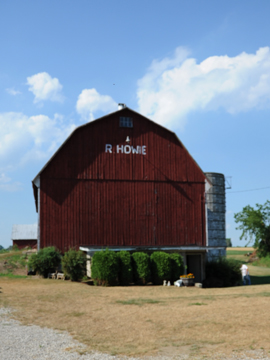
A term that the people in this part of Canada use readily is severed. They all talk about how the farm-house has been severed. This means that the house and some added land is separated from the larger acreage and sold. (The original Crown deeds, in this part of Upper Canada, were 150 acres.) Rainer and Lynne’s house was severed from the farm land that surrounds it. And to add one more twist, the house that Lynne’s dad and his wife lives in, is the same house that his wife was born in and grew up in. The house was severed and they bought the farm-house from her family – the Howies. The property includes the original barn with the R. Howie name on it.
It become clear that the community, in this farm region, has many families that have been in the area for generations. The families have intermarried and consolidated and re-divided the original Crown deeds to create a new patch-work of farms.
The inter-connectedness reminds me of the hill-towns in Calabria. Just as Lynne can point to all the families that are inter-connected in Harrow, I can point to all the families that are inter-connected in Aprigliano.
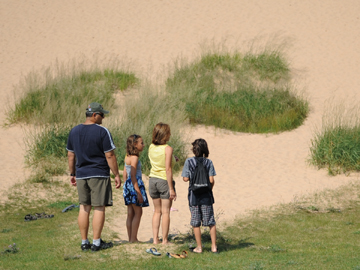
 In lieu of Italy, I spent a week in northern Michigan. Actually on the north-eastern shore of Lake Michigan. The area is nothing like Northern Ontario and the other Great Lakes. It has dunes, sandy beaches, resorts, cherry orchards, golf-courses and cultivated pine-groves. The image on the left is Dom, Alyssa, Mary and Daniel getting ready to climb the dune in the National Lakeshore Park.
In lieu of Italy, I spent a week in northern Michigan. Actually on the north-eastern shore of Lake Michigan. The area is nothing like Northern Ontario and the other Great Lakes. It has dunes, sandy beaches, resorts, cherry orchards, golf-courses and cultivated pine-groves. The image on the left is Dom, Alyssa, Mary and Daniel getting ready to climb the dune in the National Lakeshore Park.
It was a surprise to find National Lakeshore, I had no idea that the east coast of Lake Michigan is protected parkland. (In all the years that I’ve been traveling through Michigan, this is the first time that I ever visited the eastern shores of the Lake.)
I always assumed that Lake Michigan would be much like the other Great Lakes rocky and rugged. Instead it’s sand and gentle, rolling hills. It’s fields of sunflowers and beautifully manicured greens. It’s farmland and orchards. It’s the refuge of the car-manufacturing gentry escaping the industrial south for the dunes and shores of the “up-north”.
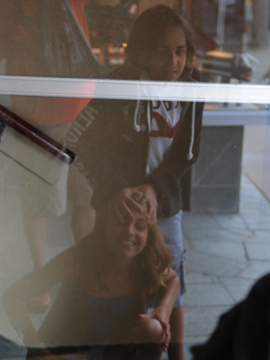
 One of the things I enjoyed best about the trip was spending time with Daniel and Alyssa. The image on the right is a reflection – Daniel is being an eighth-grader and messing with his sister. (I’m glad to see Alyssa is still patient. Hope it lasts.) The five of us – Mary, Dom, Daniel and Alyssa – decided to spend an evening walking the downtown. The children and I ate gelato, dissed the tourists and mugged in every window.
One of the things I enjoyed best about the trip was spending time with Daniel and Alyssa. The image on the right is a reflection – Daniel is being an eighth-grader and messing with his sister. (I’m glad to see Alyssa is still patient. Hope it lasts.) The five of us – Mary, Dom, Daniel and Alyssa – decided to spend an evening walking the downtown. The children and I ate gelato, dissed the tourists and mugged in every window.
Traverse City is beautiful. It has a nice balance. It is not some cheap beach-town littered with souvenir shops and trashy stores or some northern Michigan back-water, hick town. Rather the downtown is manned by local merchants who have managed to keep out the national chains, the graffiti and the garbage. They offer coffee shops manned by local kids, t-shirts designed and printed by local artisans. A canal edges the downtown allowing boats to dock; boaters to pick up pizza; ducks to swim and dive for food; tourists to shop for taffy and t-shirts; locals to work in a tourist environment without being swallowed up by the outsiders. The harbor is filled with motor-boats and sail-boats. It is landscaped with retaining walls and slips. And the sunset colors it red.
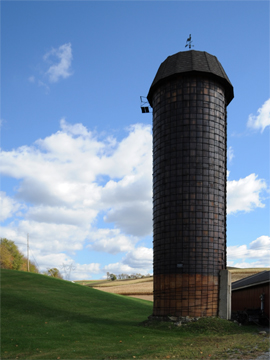

Our fall-foliage trip took us through Westmoreland County. I’ve traveled the turnpike for years, but have never gone exploring the country roads that surround it.
What made the shoot at this furniture store was the tile silo and the blue-blue sky. I haven’t had the opportunity to aim at the blue vastness and the white clouds in the while. The fields that bordered the landscape were gold with cut-wheat and cut-corn. The soybeans dried tan and added a haze to the horizon.
Other silos that I’ve shot have been skeletons – white-washed, cracked and empty – of bygone days. This one near Pleasant Unity, Pennsylvania was made of shiny tiles that were in great shape and it sported a weathervane on its copper cap. The bottom tiles still held their original burnt-red tint. I suspect this section was originally buried and uncovered when digging for the parking lot; or during the renovation when the barn was converted into a furniture store. The tiles on the tall section are shiny black, probably stained by the coal-soot that filled the skies of Western Pennsylvania in the long ago.
But Saturday the ebony silo, the golden fields and the marshmallow clouds filled the indigo skies – what joy.
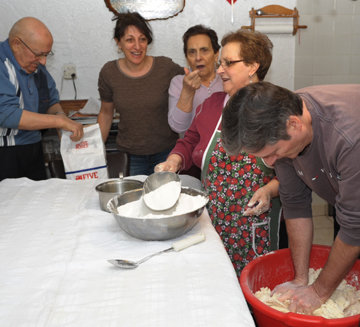

Rose, Derrick and my aunt came over to my parents’ to make a batch of cullurielli. These doughnut-like fritters are a Christmas staple. The dough is made with potatoes, flour and water. And they are shaped into rounds and longs. The longs have sardines in them. They are first eaten on Christmas Eve in place of bread. (My favorites are the ones with the sardines and I like them straight out of the freezer. Everyone in my family already thinks I’m strange, this culinary choice reinforces their prejudices.)
Part of the reasoning for a second batch of cullurielli was getting Rose, Derrick and I to see how to make these Christmas bread-substitutes. The process took the whole day. We began by mixing the dry and wet ingredients, then kneading and kneading the rough dough. This was followed by leavening and an hour later we were rolling the rounds and the longs. I had no idea who was going to eat all these cullurielli. I refuse to take any home, because after all the ethnic eating I need to get back to a sensible diet. . . (left-to-right – my dad, rose, my mom, my aunt, derrick)
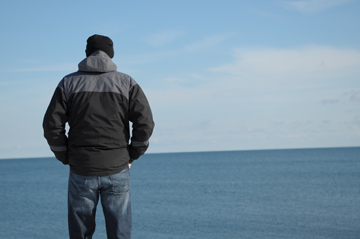
Oliver and I went down to Narragansett. He was interested to see if it was somewhere he and Luz could spend a weekend. I was interested in seeing the Novitiate, the rocks and the beach.

We began at the northern end, at the surfers’ beach, and then drove south on Ocean Road to the Novitiate. I got to tell about my life in the monastery and Oliver was amazed by the story. (I guess thirty-something Jewish Californians don’t know about Medieval European monasticism.) It was also fun being on the Novitiate grounds with someone who was neutral to the idea of my having lived there as a monk.
The next stop was Black Point. This is a small state park, an ocean-access area, across the road from the Novitiate. The strip of land is wooded and has a path down to what we called the rocks. This is an ocean-front of rock and shallow pools. We would walk down to the rocks at least once a week. I remember seeing star-fish in the shallow pools. I took one back to my room, thinking that it would dry and I’d have a souvenir. The smell of rotting flesh was enough to convince me to never try that experiment again.
In January of 1969 a group of novices rescued three fishermen that had run aground on the rocks. We formed a human chain and pulled the men out of the freezing ocean. We made all the local papers. The headline read – Brothers to All.
..

There is a famous picture of me in profile and with hair, sitting on the rocks and wistfully looking out to sea. It was my last summer at Narragansett. Bill Green took the picture without my knowing. (He gave it to me when we were leaving the Novitiate.) Bill’s photograph is soft, pretty and romantic.
I’ve always wanted to take a similar picture and I got the opportunity with Oliver as the subject. The above-left picture is my version of the 1969 photograph. Gone is the summer, gone is the longing, gone is the innocence.
Welcome to blue and black, welcome to geometry.
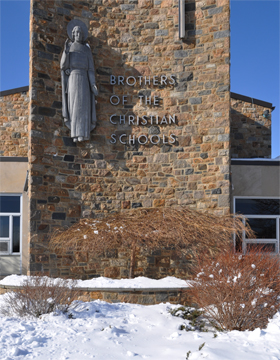

It was a cool Monday evening in July; it was 1969. We had finished Compline – evening prayer – and Tom and I had gone for a walk around the grounds. We ended up in front of the chapel beneath the statue of John Baptist de la Salle. We sat on the edge of the flowerbed looking up at the night sky.
Three-hundred-and-eighty-four thousand miles away, Neil Armstrong and Buzz Aldrin stepped onto the lunar sands. Apollo had landed.
The photograph on the left is the front of the chapel, but it’s forty-two years later. The flowerbed now holds a Japanese maple and snow covers that summer’s memories. But as I focused my lens on the statue, the signage, the flowerbed, it was easy to see the two eighteen year-olds sitting on the shelf and looking up at the night sky.
It was a summer of great change. In a month we all scattered and left Narragansett forever. The young brothers and the teachers that had lived together were all re-assigned back to their districts. Most I never saw again. (I went back to Canada and the University of Windsor, Tom went to DC and Catholic University.)
But I always remember where I was and who I was with when the Eagle landed and Armstrong anointed earth’s moon.
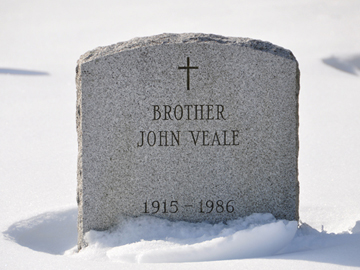
I’m working on a Novitiate text-page and it’s slow going, mainly because I’m not sure how to tell the story. The narrative of my time in the Novitiate is a bit complex. Which story do I tell – the John Veale one, the Benilde story, the house-driver story, the dorm-cloister story, the windmill-cottage story, the wrestling-in-the-grass story?
The Brother John Story – I had placed this grave-marker image at the end of the set, the last one on the text-page, but instead decided to start the series and the narrative with it. I wanted to lead with it as he was such a huge figure in that long-ago time. He was the Director of Novices and he still permeates the perimeter of my feelings about that long-ago.

Each novice met with the Director once a week. It was my first experience with one-to-one counseling. I remember complaining to him, because the Brother Provincial would pull me out of afternoon Manual Labor to play tennis. (Manual Labor was one of the rhythms of novitiate life.) Can you imagine complaining about not doing manual labor? And my Manual Labor assignment was cleaning the common rooms on the ground level. I hate cleaning. I refuse to do it now, but back then I complained about not getting to do it. Actually, I did not like being excused from the Manual Labor assignment when everyone else still had to do it. (Even back then I had socialist tendencies.)
I’ve got the text-page done, but am procrastinating on the captions. The story-telling happens in the captions. Now, I can make the captions as cryptic as I want after all I am the author and who’s going to challenge their authenticity?
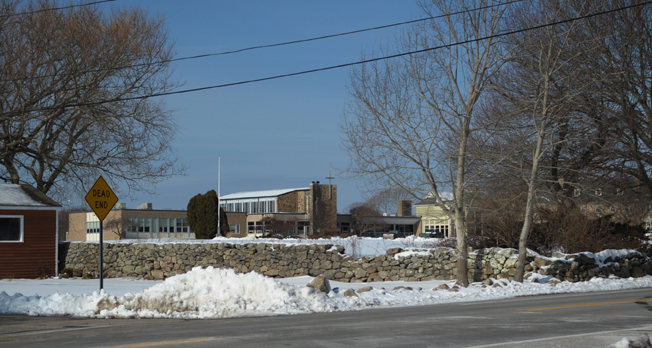
The photograph is of the southern corner of the Novitiate property – Ocean Road and Rhode Island Avenue. (The chapel is in the background.) This is the corner we always used to exit the grounds and go down to the beach or go walking through town. We would change out of our religious habits and into street clothes and head out across the front lawn. In the dark we were smudges on the manicured grass. We would climb the stone wall, both literally and metaphorically and walk out of the enclosure.

Thirty years later the top stones, at this southern end, are still missing. The breach is still there. (The cap stones lie piled on the lawn-side and serve as steps and ramp to the top, to the gap.) The corner is obviously still an exit-point.
Let me talk about the ‘Dead End’ sign. I intentionally included it in the photograph when I first saw it through the view finder. Second, I refused to Photoshop it out even if it’s going to be seen as a blight on the winter landscape. And third, I’m using a larger image-format so as not to lose the sign.
Is the yellow diamond, like the wall, both literal and metaphorical? Was the thought process that brought it into the photograph a subconscious statement?